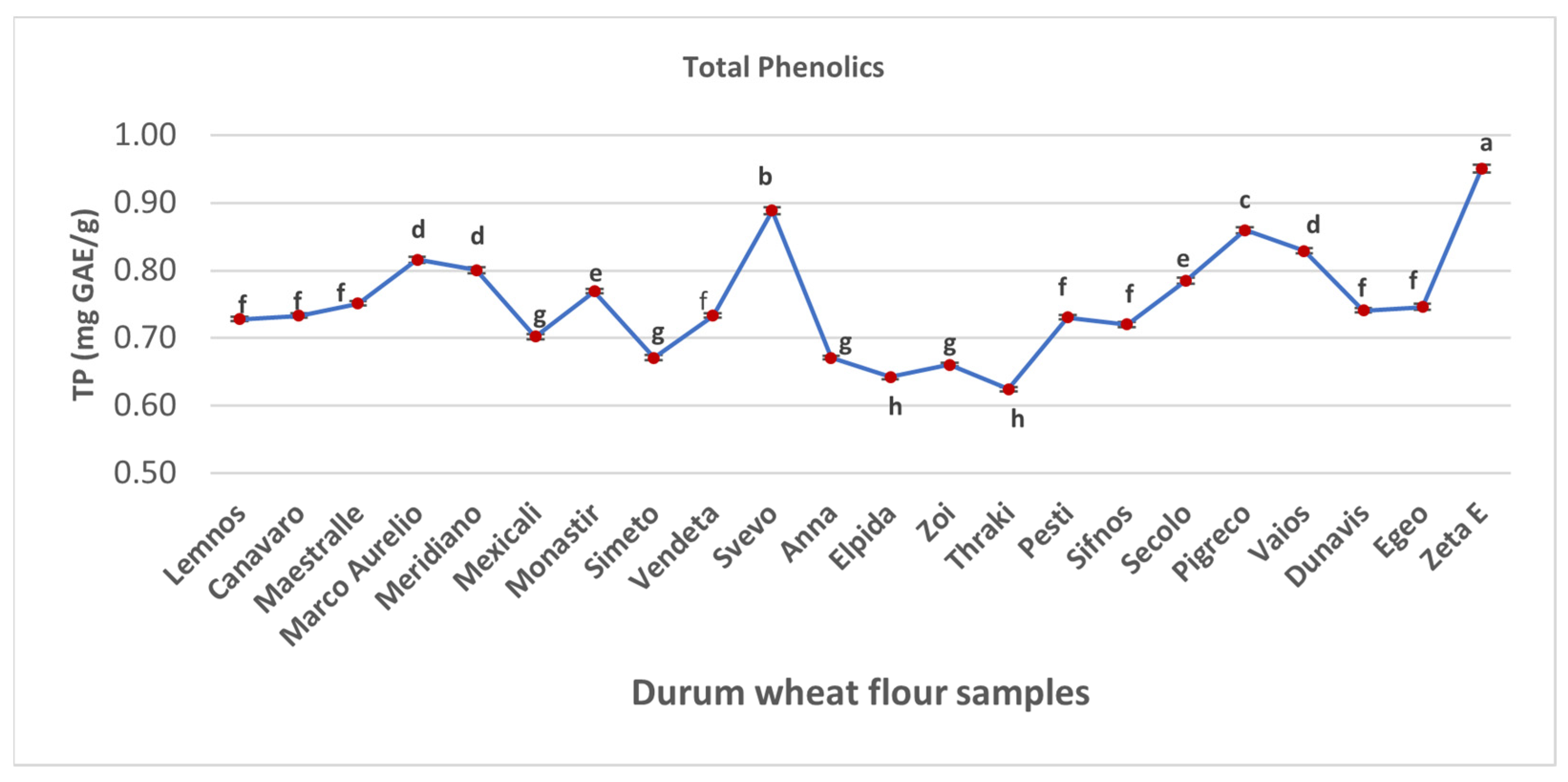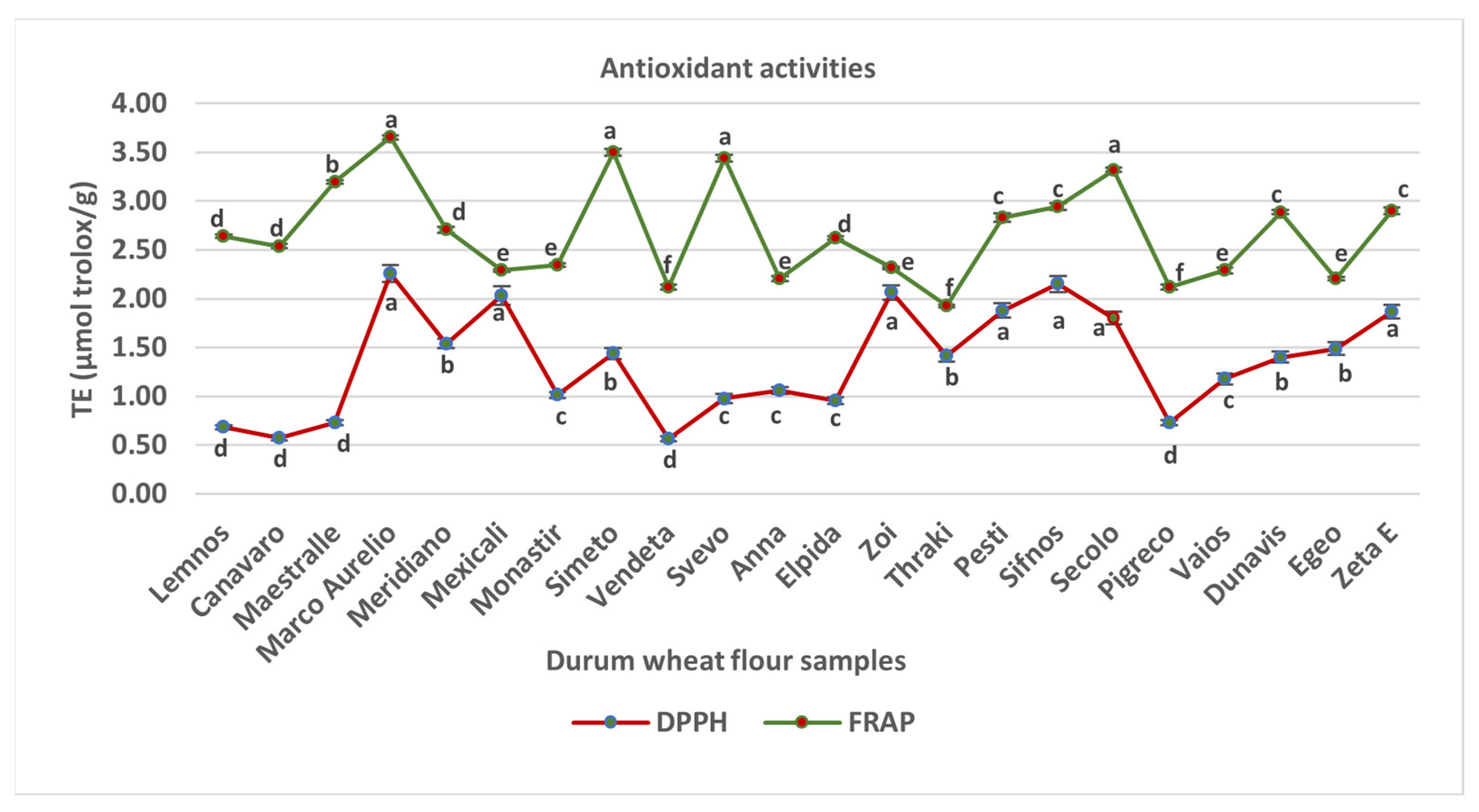1. Introduction
There is a growing focus on the connection between modern diets and lifestyles and various health issues, such as cardiovascular disease and malignancies in the digestive system. In recent years, there has been a notable rise in the consumption of nutritious food due to heightened consumer awareness and health-related considerations.
At the same time, it is projected that the global production of wheat will surpass 770 million tons in the year 2024. Wheat constitutes a significant proportion of Greece’s agricultural output. According to a reliable source, it was projected that Greek wheat output would exceed the threshold of one million tons in the year 2024 [
1]. One of the primary agricultural crops cultivated in Greece is durum wheat (
Triticum turgidum L. var. durum). The use of durum wheat flour in the food industry provides both nutritional and economic advantages to Greece.
Bakery products from durum wheat are considered staple foods due to their significant contribution to energy and nutrition, mostly attributed to their substantial carbohydrate and protein composition. Furthermore, wheat has essential nutrients and phytochemical compounds that are crucial for maintaining optimal health. Several phytochemicals included in wheat grains have been well acknowledged for their substantial biological impacts [
2,
3,
4]. Wheat has the potential to possess secondary metabolites, such as polyphenols. Chemical compounds such as phenolic acids, coumarins, flavonoids, stilbenes and lignans are included under the aforementioned group [
3,
4]. Previous studies have shown evidence of the antioxidant, anti-inflammatory, antimutagenic and anticarcinogenic characteristics associated with polyphenols [
4,
5].
It has been shown that oxidative stress, inflammation and thrombosis are implicated in the development of several health conditions, including cancer, atherosclerosis, rheumatoid arthritis and neurological disorders [
6,
7]. The capacity of antioxidants to eliminate free radicals and mitigate oxidative harm is well recognized [
6]. Therefore, it is recommended to increase the consumption of foodstuffs that are high in antioxidants.
The aim of the study was to comparatively evaluate the antioxidant and antiplatelet potential of flours from 22 selected durum wheat varieties (Triticum turgidum L. var. durum) cultivated in Greece so that it is possible to select flours of those varieties that have the greatest possible antioxidant and antiplatelet activities.
2. Materials and Methods
2.1. Materials
There were 22 flour samples from different durum wheat (Triticum turgidum L. var. durum) varieties kindly offered by the Institute of Applied Biosciences at the Centre for Research and Technology Hellas (INAB|CERTH, Thessaloniki, Greece).
2.2. Extract Preparation
The flour samples were extracted with aquas methanol 80% (
v/
v) according to Armelin et al. [
8] with some modifications. Briefly, the samples were agitated in an orbital shaker (GFL 3017, GFL; Burgwedel, Germany) at 200 rpm for 2 h at room temperature and then centrifuged at 1200×
g force for 10 min (Ortoalresa, Digicen 21R, Madrid, Spain). The supernatant was stored at −40 °C until being further analyzed for total phenolics, antioxidant activities and antiplatelet activity.
2.3. Total Phenolics
The total phenolics were measured in triplicate by using the Folin–Ciocalteu method as previously described [
9] using a spectrophotometer LAMBDA 25 (Perkin Elmer, Norwalk, CT, USA). The results were expressed as equivalent concentrations of gallic acid (mg GAE per g flour).
2.4. In Vitro Antioxidant Activities
The antioxidant activities were evaluated using the DPPH and FRAP assays as previously described [
9]. Each sample was examined in triplicate. Trolox solutions were prepared in the appropriate concentrations for quantitation purposes and the results expressed as Trolox equivalents in μmol per g of flour.
2.5. In Vitro Antiplatelet Activity
The in vitro antiplatelet activity was evaluated on an aggregometer (CHRONO-LOG Corporation, 500CA, Havertown, PA, USA) according to the ability of the samples to inhibit the lipid mediator of platelet-activating factor (PAF) toward human platelet-rich plasma (PRP) as described previously [
10]. The in vitro antiplatelet activity was expressed as mg
−1 required for 50% inhibition of PAF activity for human PRP.
2.6. Statistics
Statistical analysis was performed using the SPSS software (IBM© SPSS® ver 28.0, IBM UK Ltd., Portsmouth, UK). The data were analyzed for normality using the Shapiro–Wilk test. Homogeneity of variance was checked using Levene’s test. Data between the flours from different cultivars were compared statistically using one-way analysis of variance with a post hoc Bonferroni test for p < 0.05.
3. Results and Discussion
The data for the total phenolics, antioxidant activities and antiplatelet activity were all normally distributed, as assessed using the Shapiro–Wilk test (p > 0.05). They passed Levene’s test for homogeneity of variance (p > 0.05), and one-way ANOVA with post hoc Bonferroni test was applied to find any statistical differences in total phenolics, antioxidant activities and antiplatelet activity between the flour samples.
3.1. Total Phenolics
The total phenolic content for the flour samples ranged from as low as 0.620 ± 0.003 mg gallic acid/g (Thraki) to as high as 0.950 ± 0.005 mg gallic acid/g (Zeta E). This indicates a significant variation in the phenolic content among the different samples. Svevo, with a total phenolic content of 0.89 mg gallic acid/g, has one of the highest phenolic contents among the samples. Lemnos, Canavaro and Vendeta all have a phenolic content value of 0.73 mg gallic acid/g, showing that these three samples have a similar phenolic content. The results are presented in
Figure 1. This variation of phenolic compounds among the different samples indicate possible differences in their antioxidant potential.
3.2. In Vitro Antioxidant Activities
The DPPH values also vary widely among the samples, with values ranging from 0.56 ± 0.02 to 2.26 ± 0.08. Higher Trolox equivalent (TE) values (μmol per g of flour) based on DPPH assay indicate better scavenging of free radicals. Samples like “Marco Aurelio”, “Simeto”, “Svevo”, “Secolo”, “Dunavis” and “Zeta E” have notably higher values, suggesting stronger antioxidant activity in these samples (
Figure 2). Similar to DPPH, TE (μmol per g of flour) based on FRAP assay vary across the samples, ranging from 2.12 ± 0.03 to 3.65 ± 0.02. Again, “Marco Aurelio” exhibits the highest TE value, followed by samples like “Mexicali”, “Zoi”, “Pesti”, “Sifnos”, “Secolo” and “Zeta E”, indicating stronger antioxidant potential for those flours (
Figure 2).
3.3. In Vitro Antiplatelet Activity
Higher values (in mg
−1) suggest stronger antiplatelet activity. The sample with the highest antiplatelet activity is “Zoi” with a value of 1.38, followed closely by “Pigreco” and “Anna” with equal values of 1.31 (
Figure 3). On the other hand, the sample with the lowest antiplatelet activity is “Vendeta” with a value of 0.32.
4. Conclusions
The data provide valuable information about the antioxidant and antiplatelet potential of flour samples from different durum wheat (
Triticum turgidum L. var. durum) cultivars. The community can use these data to make informed decisions about which samples may offer greater health benefits in terms of antioxidant and antiplatelet properties, which are implicated in the development of various chronic diseases [
6,
7].
Author Contributions
Conceptualization, H.C.K.; methodology, I.S.K. and H.C.K.; software, H.C.K.; investigation, I.S.K., A.M., I.G.K. and H.C.K.; resources, H.C.K.; data curation, A.M. and H.C.K.; writing—original draft preparation, H.C.K.; writing—review and editing, H.C.K.; supervision, H.C.K.; project administration, H.C.K.; funding acquisition, H.C.K. All authors have read and agreed to the published version of the manuscript.
Funding
This research has been co-financed by the European Union and Greek national funds through the Operational Program Competitiveness, Entrepreneurship and Innovation, under the call Research—Create—Innovate (project code: T2EDK-01244).
Institutional Review Board Statement
Not applicable.
Informed Consent Statement
Not applicable.
Data Availability Statement
Data are contained within the article.
Conflicts of Interest
The authors declare no conflict of interest. The funders had no role in the design of the study; in the collection, analyses, or interpretation of the data; in the writing of the manuscript; or in the decision to publish the results.
References
- Food and Agriculture Organisation of the United Nations (FAOSTAT). Available online: https://www.fao.org/faostat/en/#data (accessed on 13 September 2023).
- Graziano, S.; Marando, S.; Prandi, B.; Boukid, F.; Marmiroli, N.; Francia, E.; Pecchioni, N.; Sforza, S.; Visioli, G.; Gullì, M. Technological Quality and Nutritional Value of Two Durum Wheat Varieties Depend on Both Genetic and Environmental Factors. J. Agric. Food Chem. 2019, 67, 2384–2395. [Google Scholar] [CrossRef] [PubMed]
- Graziano, S.; Marmiroli, N.; Visioli, G.; Gullì, M. Proteins and Metabolites as Indicators of Flours Quality and Nutritional Properties of Two Durum Wheat Varieties Grown in Different Italian Locations. Foods 2020, 9, 315. [Google Scholar] [CrossRef] [PubMed]
- Giacosa, A.; Peroni, G.; Rondanelli, M. Phytochemical Components and Human Health Effects of Old versus Modern Italian Wheat Varieties: The Case of Durum Wheat Senatore Cappelli. Nutrients 2022, 14, 2779. [Google Scholar] [CrossRef] [PubMed]
- Şahin, Y.; Yıldırım, A.; Yücesan, B.; Zencirci, N.; Erbayram, Ş.; Gürel, E. Phytochemical Content and Antioxidant Activity of Einkorn (Triticum Monococcum Ssp. Monococcum), Bread (Triticum aestivum L.), and Durum (Triticum Durum Desf.) Wheat. Prog. Nutr. 2017, 19, 450–459. [Google Scholar] [CrossRef]
- Kıran, T.R.; Otlu, O.; Karabulut, A.B. Oxidative Stress and Antioxidants in Health and Disease. J. Lab. Med. 2023, 47, 1–11. [Google Scholar] [CrossRef]
- Demopoulos, C.A.; Karantonis, H.C.; Antonopoulou, S. Platelet Activating Factor—A Molecular Link between Atherosclerosis Theories. Eur. J. Lipid Sci. Technol. 2003, 105, 705–716. [Google Scholar] [CrossRef]
- Armellini, R.; Peinado, I.; Pittia, P.; Scampicchio, M.; Heredia, A.; Andres, A. Effect of Saffron (Crocus Sativus L.) Enrichment on Antioxidant and Sensorial Properties of Wheat Flour Pasta. Food Chem. 2018, 254, 55–63. [Google Scholar] [CrossRef] [PubMed]
- Michalaki, A.; Karantonis, H.C.; Kritikou, A.S.; Thomaidis, N.S.; Dasenaki, M.E. Ultrasound-Assisted Extraction of Total Phenolic Compounds and Antioxidant Activity Evaluation from Oregano (Origanum Vulgare Ssp. Hirtum) Using Response Surface Methodology and Identification of Specific Phenolic Compounds with HPLC-PDA and Q-TOF-MS/MS. Molecules 2023, 28, 2033. [Google Scholar] [CrossRef] [PubMed]
- Achilladelis, P.; Petsas, A.S.; Karantonis, H.C. Effect of Fortification of Tahini with Natural Plant Origin Raw Materials on Its Bioactivity. Appl. Sci. 2023, 13, 9626. [Google Scholar] [CrossRef]
| Disclaimer/Publisher’s Note: The statements, opinions and data contained in all publications are solely those of the individual author(s) and contributor(s) and not of MDPI and/or the editor(s). MDPI and/or the editor(s) disclaim responsibility for any injury to people or property resulting from any ideas, methods, instructions or products referred to in the content. |
© 2023 by the authors. Licensee MDPI, Basel, Switzerland. This article is an open access article distributed under the terms and conditions of the Creative Commons Attribution (CC BY) license (https://creativecommons.org/licenses/by/4.0/).









